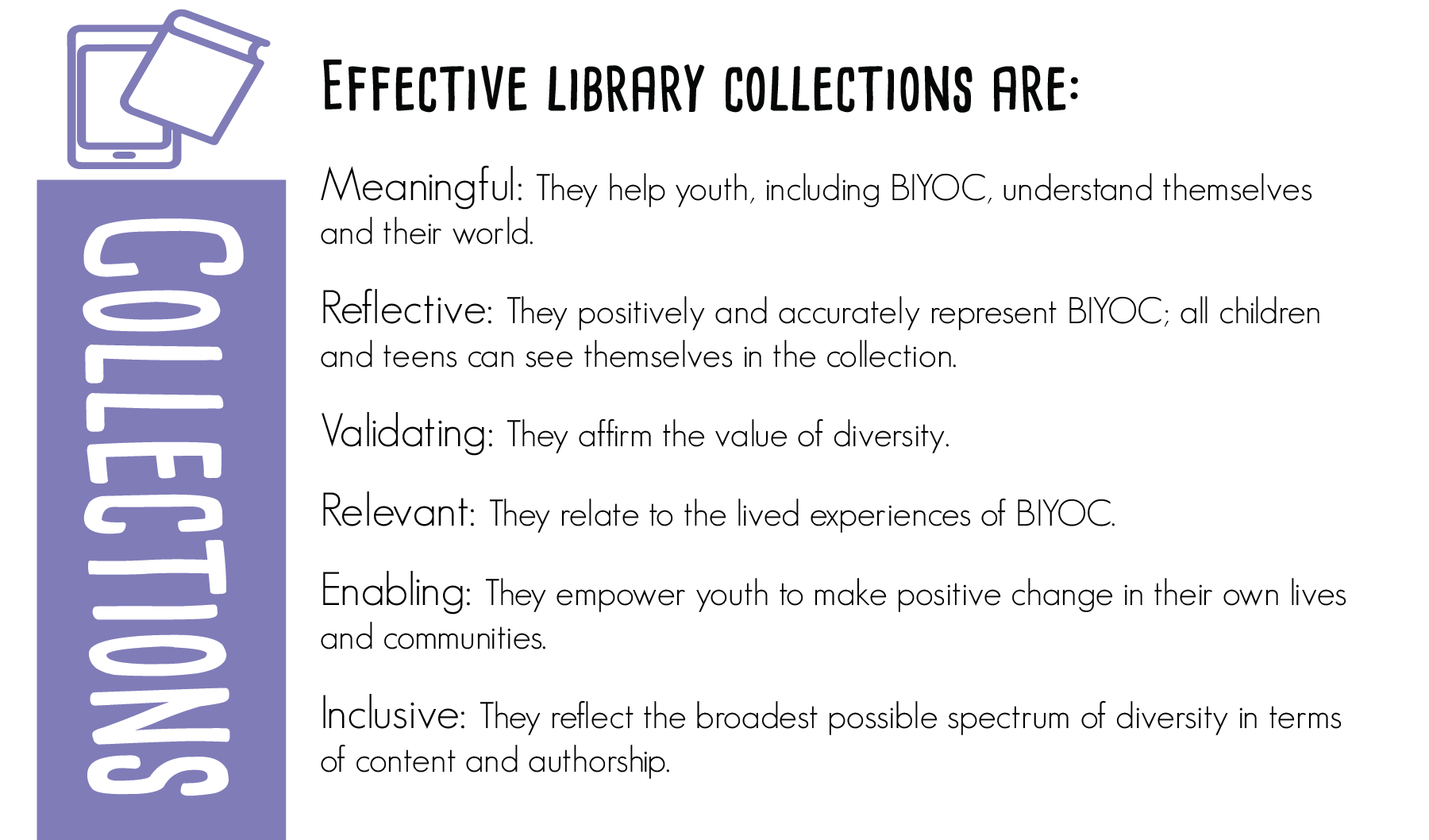| Go Back: Module 23: Transforming Library Space and Policies | You Are Here: Module 24a: Transforming Library Collections, Part 1 | Next: Module 24b: Transforming Library Collections, Part 2 |
After working through this module, you will be able to:
- Explain to your faculty, staff, administrators, and parents/caregivers the value of diverse and reflective literature.
- Evaluate your library’s collection through a racial equity lens.
- Collaboratively develop a plan to improve your library’s collection to better serve BIYOC.
Introduction
Diversity is not praiseworthy. It is reality.
When we fight for diverse books, we’re really just fighting for a more honest literature. Books that tell the truth. Because when we say, “We Need Diverse Books,” we’re really saying “We Need Books That Don’t Lie To Us About Who We Are Or Whether We Exist.”
These two quotes from award-winning authors get to the heart of effective library collections for BIYOC. The library’s collection explicitly and implicitly communicates information about whose lives are valued, whose stories deserve telling, who gets to tell their stories, and who is welcome in the space. Inclusive and equitable library collections contain books that reflect the lived experiences of BIYOC and their communities, in particular, #OwnVoices books! In this module, we will explore strategies for creating library collections that are welcoming and affirming for BIYOC, share examples of libraries that are putting these strategies to work, and provide guidelines for equitable library collections that you can use to plan for improvements within your own context.

Why Diverse Literature?
Before we examine the characteristics of effective library collections for BIYOC, let’s pause for a moment and consider why it is important for our collections to be diverse. While we may all understand why our libraries should be rich with diverse books, we may need explanations to share with colleagues, administrators, and parents/caregivers – especially as we advocate for using diverse literature across the curriculum with all students.
Let’s start with why it is important for BIYOC and other marginalized youth. Texts that reflect their personal experiences and accurately portray characters that look like themselves and their families, friends, and peers:
- Validate their existence and lived experiences (Bishop, 1990; Tatum, 2009; Tatum; 2017)
- Connect them with their textual lineage & history (Banks, 1999; Tatum; 2009; Tatum; 2017)
- Counter the “single story” – the premises, myths, and stereotypes that are often held by the dominant white culture (Adichie, 2009; Delgado, 1989; Tatum, 2009; Tatum; 2017)
- Support positive racial and ethnic identity development (Hanley & Noblit, 2009; Tatum, 2009; Tatum; 2017)
- Increase engagement with reading & other academic subjects (Edwards et al, 2010; Tatum, 2009; Tatum; 2017)
- Provide positive images of the achievement of members of marginalized communities (Banks, 1999; Tatum; 2009; Tatum; 2017)
- “Provide healing from the damages of living in a racist society.” (Barker, 2010)
 Watch
Watch
In this interview on The Daily Show with Trevor Noah, award-winning author Jason Reynolds talks about how diverse literature can support young people of color in developing positive relationships with literacy.
In this TED Talk, award-winning author Grace Lin shares her experiences growing up as a member of the only Asian American family in her community and the lack of Asian representation in books.
 Reflect
Reflect
Think of one specific BIYOC you have worked with. How do you think this child or teen would react to seeing their life experiences authentically represented in the resources in the library? In the texts and other resources used in the classroom curriculum? In what ways would it be sustaining for them?
But what if you work in a community with little diversity? All youth benefit from diverse literature. In the blog post Why Do We Need Diverse Books in Non-Diverse Schools?, Taun M. Wright shares research showing that exposure to diverse literature and diverse cultures leads to:
- Increased Academic Performance. Reading diverse books has been found to support “identity-safe classrooms” for all youth, a key factor in increased achievement.
- Increased Engagement in Reading. In studies, children and teens have indicated that they want to read books where the characters do not all look the same. “I like reading about people that are different than me.” “Books about kids that are different than the kids in my class are interesting.”
- Better Prosocial Development. Research has shown that youth who read a book with intercultural topics showed “not only a reduction in stereotyping and more positive feelings about students representing identities other than their own, but also an increased desire to engage in future contact.”
- College and Career Readiness. Reading diverse literature can help youth learn to respectfully collaborate and communicate with people from different cultural groups, key 21st century skills.
Additionally, reading literature can create a shared understanding and appreciation for the historical and current social, political, economic, and scientific contributions of marginalized communities to American society and the world (Tatum, 2017), and provide a forum for youth to talk about race, ethnicity, gender identification, sexual orientation, and disability in transformative ways (Hughes-Hassell, 2013).
 Watch
Watch
In her TED Talk, “The Danger of a Single Story,” novelist Chimamanda Ngozi Adichie warns that if we hear only a single story about another person, culture, or country, we risk not only critical misunderstandings, but we also rob people of their dignity and power.
 Reflect
Reflect
Watch this video of award-winning author Sharon G. Flake’s poem “You Don’t Even Know Me,” performed by Black male students from Roseville High School in Minnesota. In what ways would using this poem with students benefit youth of color in your community? White youth in your community?
 Review
Review
In Module 21, we introduced the five-part framework of Effective Library Services for Diverse Youth. Based on our own research and discussions with BIYOC as well as the research of others working in the library and education fields, we have identified six key features of effective library collections for BIYOC.

 Reflect
Reflect
In your response journal, reflect on each of the six features of effective library collections. For each characteristic, come up with 3-5 specific ways that a library might embody that feature: What would a _______ library collection look like? Try to think creatively and go beyond the brainstorming ideas you came up with in Module 21. Your examples might come from your own library or libraries you’ve visited before, but you can also think outside the box to explore new ways that collections might meet these benchmarks. Be sure to consider not only the physical collection but also the library’s digital collection.
When you’re done, click here to see some of our ideas - but note that our list is not exhaustive. Use one of the following tools to collaboratively assess your library’s current collection for its cultural responsiveness. Be sure to include input from BIYOC in the process. After assessing your current collection, set three goals for improving it: one short-term goal that you can accomplish immediately, one medium-term goal that you can accomplish over the next several weeks, and one long-term goal that you can accomplish over the next year. Use the Goals for Improving Library Services for Diverse Youth [PDF] template to write these goals down. We suggest printing this document (in poster size if possible), laminating it, and using it to track all of your goals related to the material in the next several modules. Post these goals somewhere in your library, and work with youth and other library stakeholders to achieve them. Once you have achieved a goal, replace it with another one. COUNTERSTORY TELLING – A concept introduced by critical race theorist Richard Delgado to describe a method of “telling the stories of those people whose experiences are not often told.” Texts that act as counterstories validate the life experiences of BIYOC and challenge the versions of reality held by the dominant culture. Refer to Module 22 for examples of how counter-storytelling can be used in instruction. ENABLING TEXTS – A concept developed by Dr. Alfred Tatum [PDF] to describe texts that: The concept can also be applied to texts that feature other marginalized communities. #OWNVOICES –Begun as a Twitter hashtag created by author Corinne Duyvis to recommend books about diverse characters that are written by people who share those identities, #OwnVoices has become a movement calling for library staff to purchase books by marginalized authors and illustrators – books that authentically and accurately portray their lives. Note: We Need Diverse Books no longer uses the term #OwnVoices, because of “the vagueness of the term, which has then been used to place diverse creators in uncomfortable and potentially unsafe situations.” Instead, they recommend (and we agree) that it is important to use the “language that authors want to celebrate about themselves and their characters.” To read more go to their blog. Fifth-grade teacher and edublogger Jessica (@Jess5th) Lifshitz published a post on her blog Crawling Out of the Classroom in which she describes how she engaged her fifth-grade students in analyzing their classroom library for its cultural responsiveness and relevancy. Read her post, titled “Having Students Analyze Our Classroom Library To See How Diverse It Is.” As you read the post, respond to the questions below in your journal: (See Module 24b for additional suggestions) In this section, we address common questions and concerns related to the material presented in each module. You may have these questions yourself, or someone you’re sharing this information with might raise them. We recommend that for each question below, you spend a few minutes thinking about your own response before clicking the arrow to the left of the question to see our response. Hogan, K.(2011). Tribal libraries as the future of librarianship: Independent collection development as a tool for social justice. In Loriene Roy, Anjali Bhasin & Sarah K. Arriaga (eds.) Tribal libraries, archives, and museums: Preserving our language, memory, and lifeways (p. 81-103). Lanham: Scarecrow Press. Adiche, C. N. (2009). The danger of a single story. Filmed July 209 at TEDGlobal 2009. Banks, J. A. (1999). An Introduction to Multicultural Education.2nd ed. Boston, MA: Allyn and Bacon. Barker, J. (2010). Racial identification and audience in Roll of Thunder, Hear My Cry and The Watsons Go to Birmingham–1963. Children’s Literature in Education, 41, 118-145 Bishop, R. S. (1990). “Mirrors, windows, and sliding glass doors.” Perspectives: Choosing and Using Books for the Classroom, 6(3). Delgado, R. (1989). Storytelling for oppositionists and others: A plea for narrative. The Michigan Law Review Association, 87, 2411-2441. Edwards, P. A., McMillon, G. T., & Turner, J. D. (2010). Change is gonna come: Transforming literacy education for African American students. Newark, DE: International Reading Association. Hanley, M.S., & Noblit, G.W. (2009). Culturally responsiveness, racial identity, and academic success: A review of the literature. Retrieved April 18, 2014, from http://www.heinz.org/UserFiles/Library/Culture-Report_FINAL.pdf Hughes-Hassell, S. (2013). Multicultural young adult literature as a form of counter-storytelling. The Library Quarterly: Information, Community, Policy, 83(3), 212-228. Tatum, A.W. (2009). Reading for their life. Portsmouth, NH: Heinemann Publishing. Tatum, A.W. (2013). Fearless voices: Engaging a new generation of African American adolescent male writers. New York: Scholastic. Tatum, B.D. (2017). “Why are all the Black kids sitting together in the cafeteria?” And other conversations about race. Revised and Updated. New York: Basic Books.
![]() Act
Act
Terms to Know…
![]() Images of Practice
Images of Practice
Selected Resources for Selecting Diverse Books…
![]() BUT WAIT!
BUT WAIT!
![]() Additional Resources
Additional Resources
References and Image Credits
Go Back:
Module 23: Transforming Library Space and PoliciesYou Are Here:
Module 24a: Transforming Library Collections, Part 1Next:
Module 24b: Transforming Library Collections, Part 2
